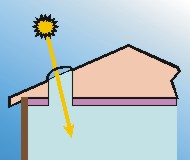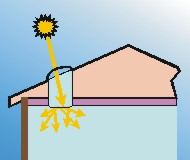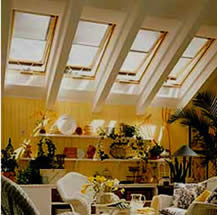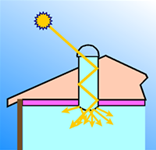
![]()
Advice to homeowners on skylights
Skylights can provide copious illumination in areas too remote from windows in walls to receive adequate daylight. Under overcast skies, these "roof windows" can remove that gloomy feeling when rooms are inadequately illuminated. Under clear skies, however, managing direct beam sunlight can be a challenge. Direct sunlight is so bright that its unobstructed entry makes for very uneven room illumination and can produce serious glare and localized overheating. Avoiding the problems while taking advantage of the the benefits is what we want from good skylight design, selection, and management.
As with any lighting system design, it is important to match the source to the illuminated space and the needs of the occupants. In generally cool climates, and especially in those regions with skies more cloudy than clear, completely clear skylights with relatively large areas may be appropriate. For many people living in generally cold and overcast climates, glare and overheating are nearly nonexistent and can even be considered desirable amenities since they are infrequently present.
 In areas boasting clear skies most of the time and especially
in hot climates, skylight areas need to be modest in relation to room
areas. Managing direct beam entry is also essential to avoid glare
and overheating. The direct sun entering an unshaded skylight can produce
what might be called "killer
glare" and localized overheating. For more information on glare, see
our glare
tutorial.
In areas boasting clear skies most of the time and especially
in hot climates, skylight areas need to be modest in relation to room
areas. Managing direct beam entry is also essential to avoid glare
and overheating. The direct sun entering an unshaded skylight can produce
what might be called "killer
glare" and localized overheating. For more information on glare, see
our glare
tutorial.
The remainder of these remarks apply to the latter case—hot climates with frequent clear skies. In such situations, there are many choices for avoiding the worst of the problems. These include incorporating diffusely transmitting materials to skylight glazing systems or wells, incorporating coatings to glazing surfaces, adding fixed or operable shades, or using tubular daylighting devices.
Diffusing Skylights
 If the dome is made diffusely transmitting—giving it a milky-white
appearance—it will diffuse the direct beam sunlight striking it, sending
the light down into the room below in many directions, producing a
softer, more uniform illumination. Since much of the light striking
the diffuse dome will be diffusely reflected upwards, not quite as
much light will enter the room as would be the case if the dome were
perfectly clear, it might be best to use a slightly larger skylight area
in this case.
If the dome is made diffusely transmitting—giving it a milky-white
appearance—it will diffuse the direct beam sunlight striking it, sending
the light down into the room below in many directions, producing a
softer, more uniform illumination. Since much of the light striking
the diffuse dome will be diffusely reflected upwards, not quite as
much light will enter the room as would be the case if the dome were
perfectly clear, it might be best to use a slightly larger skylight area
in this case.
If the skylights you wish to purchase do not come with a diffusing dome option, you can instead place a flat or domed glazing across the bottom of the light well, as shown in the illustration. In this case the skylight will look more like a fluorescent light fixture than a skylight, but there will be no mistaking it for a skylight as you see the shadow of the edge of the shaft above creep across the diffuser as the sun moves through the sky during the middle of the day.
Spectrally Selective Coatings
If it is the solar heat gain you wish to avoid rather than the glare of direct beam entry, you can ask for a low solar gain low-e coating in the top glazing system. These coatings are described in the "How windows work" section of this web site, more particularly in the solar gain tutorial.
The coating will transmit the sunlight essentially unimpeded, but will reflect the invisible infrared portion of the solar radiation incident on the skylight, thereby reducing the solar heat admitted by the skylight without much illumination reduction.
 |
| Credit: www.velux-america.com |
|---|
Shading Skylights
The diffusing option described above has the important advantage of doing its job all the time, without need for any intervention by the occupant. It has the disadvantage of blocking the view up out of the skylight, an important feature of some skylight installations, especially those on steeply sloping roofs. In such situations, you may find it better to install an operable shade on the skylight. This way you can block the direct beam when it is objectionable while still opening the skylight for a clear view of the outdoors and to admit the maximum daylight illumination at other times.
Though it is generally best to block the sun's heat before it reaches the glazing, using some form of exterior shade or shutter, with skylights, such devices are generally considered unsightly or are not easily anchored to the building sufficiently to protect them from strong winds, so skylights almost always have interior shades attached to them, as illustrated in the photograph above.

Tubular
Daylighting Devices
Tubular skylights are reflective cylinders or pipes placed between the roof and ceiling of a building. A clear plastic dome is sealed over the top of the cylinder to keep rain and dust out. Since the tube is so reflective that it would otherwise send bright, glare-producing sun rays into the room below, a flat or domed diffusing glazing is placed across the bottom of the cylinder, in the ceiling plane, much as shown schematically in the illustration.
Energy Savings
Conventional wisdom has it that residential buildings do not offer significant opportunities for energy savings due to daylighting from windows or skylights. This is attributed to the relatively low daytime occupancy levels of most such buildings and the consequently low daytime need for electric lighting. Skylights, in particular, offer serious problems for residential energy savings, especially in cases where the skylights are oversized and the solar gain and over-illumination are inadequately managed. In these cases, skylights can increase rather than decrease building energy costs. There are many exceptions to this rule, including cases where the occupants are at home most of the day, due to being retired or otherwise employed at home and where the fenestration systems are properly designed and managed to minimize the problems described previously. Energy costs and savings can be estimated with the help of a variety of performance calculation computer programs. A couple are mentioned in the next section.
Sizing Skylights
Horizontal illumination outdoors on a clear day is about 60,000 lux about 85% of which is from the direct beam sunlight. A reasonable level of illumination in a room for reading tasks is around 600 lux. If the light from your skylights were to be evenly distributed over portion of the room to be illuminated by the skylights, and if we assume that the skylights transmit all of the illumination incident on them, then you can see that the total skylight area would need to be about 1% of the illuminated area, since 600 is 1% of 60,000. If the skylights transmit only 50% of the clear sky daylight incident on them, then you would need to double the skylight area to compensate. For those times (morning, afternoon, and under overcast skies) when the outside illumination is less than 60,000 lux, the skylight areas should be somewhat larger, say 4 to 6 percent of the area of the room to be illuminated. For still higher illumination levels, the skylight area can be increased further. Going too far with this, however, can introduce excessive solar heat gain. The system luminous efficacy of skylights is much higher than that of incandescent electric lighting of equivalent illumination, so there is a little room for slight oversizing of skylights
For more information on the energy consequences of skylights and for further assistance in computing the appropriate aperture areas for your application, visit the skylights web site of the Efficient Windows Collaborative. Lawrence Berkeley Laboratory's RESFEN computer program recently added an approximate skylight energy calculation option. The program is under development and its handling of skylights should be improved in the future. You can also download SkyVision, a skylight sizing and evaluation computer program from the National Research Council of Canada. For a description, click here: SkyVision description.
Once you have sized your skylights, perhaps oversizing them slightly, follow the above shading guidelines to properly manage the glare and overheating problems that can result on clear and/or hot days.
Skylights in Nonresidential Buildings
Nonresidential buildings occupied for significant portions of the daylight hours offer superior energy-saving capabilities to most residential installations. This is due to the increased ability of such systems to displace daytime electric lighting energy. This is discussed at greater length in the section on Nonresidential buildings.
